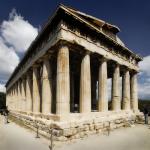|
This section contains 5,605 words (approx. 19 pages at 300 words per page) |

|
Tragedy Takes Shape.
During the sixth century B.C.E., as Greece awoke from the dark years of illiteracy and cultural deterioration, tragedy as a dramatic form began to take shape. In a performance space that consisted of a central location, known as the skene ("tent"), a half-circle called the "orchestra" in front for the chorus, and entrances on either side, tragic drama was first performed. In Poetics Aristotle describes how Thespis added an actor to the chorus who would deliver a prologue relating the content of the play and speeches separate from the choral songs. Aeschylus is said to have added a second actor, thereby allowing an exchange of dialogue between two characters, despite the fact that in some of his surviving plays, the main actor, or "protagonist," still speaks primarily to the chorus. Aeschylus' younger contemporary, Sophocles, added a third...
|
This section contains 5,605 words (approx. 19 pages at 300 words per page) |

|




